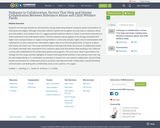
Research over the past decade has documented a strong relationship between substance abuse and problems of child abuse and neglect. Although many data collection systems do not gather accurate data on substance abuse and child welfare, most studies in the U.S. suggest parental substance abuse is a factor in one third to two-thirds of child involvement in the child welfare system. Parental substance abuse appears to be strongly associated with higher rates of physical abuse or neglect among families in community samples, higher rates of substantiated child maltreatment in cases referred into child welfare, higher rates of out-of-home placements, re-reports of abuse, and reentry into foster care. This study examined factors that help and hinder the process of collaboration based on in-depth interviews with respondents from substance abuse and child welfare fields working in five California counties with established formal collaborative policies and programs. This curriculum, which is grounded in the findings from the study, provides highlights of research and experiential activities in four primary areas that may be used independently or in combination: (a) overview of research on cross-systems collaboration, (b) promising models and elements for collaborative practice, (c) factors that help and hinder collaboration, and (d) facilitating communication and dealing with confidentiality issues across systems. (161 pages)Drabble, L., Osterling, K. L., Tweed, M., & Pearce, C. A. (2008).
- Subject:
- Social Work
- Material Type:
- Module
- Author:
- CalSWEC
- Date Added:
- 03/01/2018